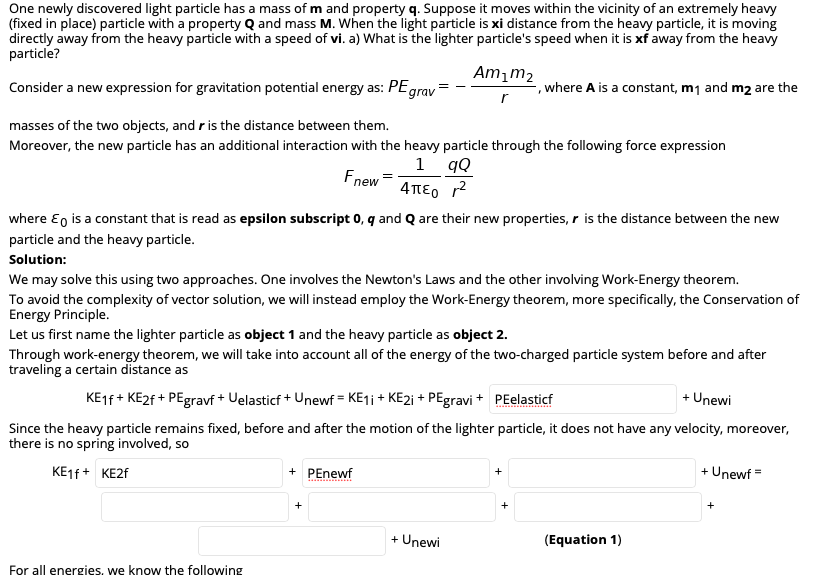One newly discovered light particle has a mass of m and property q. Suppose it moves within the vicinity of an extremely heavy (fixed in place) particle with a property Q and mass M. When the light particle is xi distance from the heavy particle, it is moving directly away from the heavy particle with a speed of vi. a) What is the lighter particle's speed when it is xf away from the heavy particle? Am¡m2 Consider a new expression for gravitation potential energy as: PE grav ,where A is a constant, m1 and m2 are the masses of the two objects, and r is the distance between them. Moreover, the new particle has an additional interaction with the heavy particle through the following force expression 1 qQ 4περ r2 Fnew where Eo is a constant that is read as epsilon subscript 0, q and Q are their new properties, r is the distance between the new particle and the heavy particle. Solution: We may solve this using two approaches. One involves the Newton's Laws and the other involving Work-Energy theorem. To avoid the complexity of vector solution, we will instead employ the Work-Energy theorem, more specifically, the Conservation of Energy Principle. Let us first name the lighter particle as object 1 and the heavy particle as object 2. Through work-energy theorem, we will take into account all of the energy of the two-charged particle system before and after traveling a certain distance as KE16 + KE2F + PEgravf + Uelasticf + Unewf = KE1¡ + KE2¡ + PEgravi + PEelasticf + Unewi Since the heavy particle remains fixed, before and after the motion of the lighter particle, it does not have any velocity, moreover, there is no spring involved, so KE1F+ KE2F + PEnewf + Unewf = + + + + Unewi (Equation 1) For all energies, we know the following
One newly discovered light particle has a mass of m and property q. Suppose it moves within the vicinity of an extremely heavy (fixed in place) particle with a property Q and mass M. When the light particle is xi distance from the heavy particle, it is moving directly away from the heavy particle with a speed of vi. a) What is the lighter particle's speed when it is xf away from the heavy particle? Am¡m2 Consider a new expression for gravitation potential energy as: PE grav ,where A is a constant, m1 and m2 are the masses of the two objects, and r is the distance between them. Moreover, the new particle has an additional interaction with the heavy particle through the following force expression 1 qQ 4περ r2 Fnew where Eo is a constant that is read as epsilon subscript 0, q and Q are their new properties, r is the distance between the new particle and the heavy particle. Solution: We may solve this using two approaches. One involves the Newton's Laws and the other involving Work-Energy theorem. To avoid the complexity of vector solution, we will instead employ the Work-Energy theorem, more specifically, the Conservation of Energy Principle. Let us first name the lighter particle as object 1 and the heavy particle as object 2. Through work-energy theorem, we will take into account all of the energy of the two-charged particle system before and after traveling a certain distance as KE16 + KE2F + PEgravf + Uelasticf + Unewf = KE1¡ + KE2¡ + PEgravi + PEelasticf + Unewi Since the heavy particle remains fixed, before and after the motion of the lighter particle, it does not have any velocity, moreover, there is no spring involved, so KE1F+ KE2F + PEnewf + Unewf = + + + + Unewi (Equation 1) For all energies, we know the following
Related questions
Question

Transcribed Image Text:One newly discovered light particle has a mass of m and property q. Suppose it moves within the vicinity of an extremely heavy
(fixed in place) particle with a property Q and mass M. When the light particle is xi distance from the heavy particle, it is moving
directly away from the heavy particle with a speed of vi. a) What is the lighter particle's speed when it is xf away from the heavy
particle?
Am¡m2
Consider a new expression for gravitation potential energy as: PE grav
,where A is a constant, m1 and m2 are the
masses of the two objects, and r is the distance between them.
Moreover, the new particle has an additional interaction with the heavy particle through the following force expression
1 qQ
4περ r2
Fnew
where Eo is a constant that is read as epsilon subscript 0, q and Q are their new properties, r is the distance between the new
particle and the heavy particle.
Solution:
We may solve this using two approaches. One involves the Newton's Laws and the other involving Work-Energy theorem.
To avoid the complexity of vector solution, we will instead employ the Work-Energy theorem, more specifically, the Conservation of
Energy Principle.
Let us first name the lighter particle as object 1 and the heavy particle as object 2.
Through work-energy theorem, we will take into account all of the energy of the two-charged particle system before and after
traveling a certain distance as
KE16 + KE2F + PEgravf + Uelasticf + Unewf = KE1¡ + KE2¡ + PEgravi + PEelasticf
+ Unewi
Since the heavy particle remains fixed, before and after the motion of the lighter particle, it does not have any velocity, moreover,
there is no spring involved, so
KE1F+ KE2F
+ PEnewf
+ Unewf =
+
+
+
+ Unewi
(Equation 1)
For all energies, we know the following
Expert Solution
This question has been solved!
Explore an expertly crafted, step-by-step solution for a thorough understanding of key concepts.
Step by step
Solved in 2 steps
